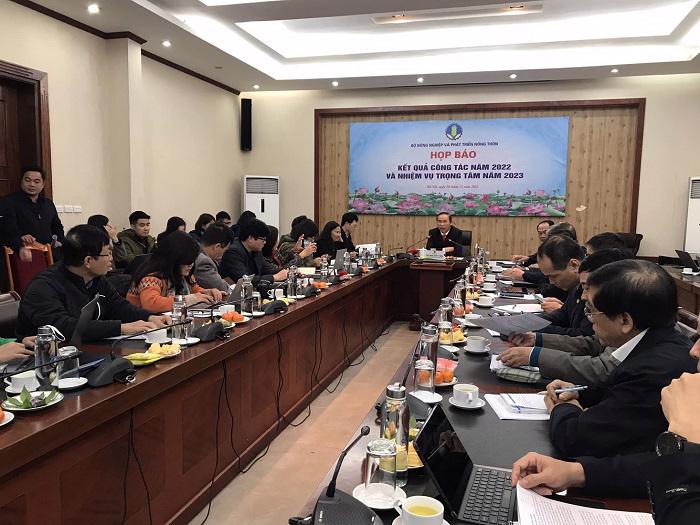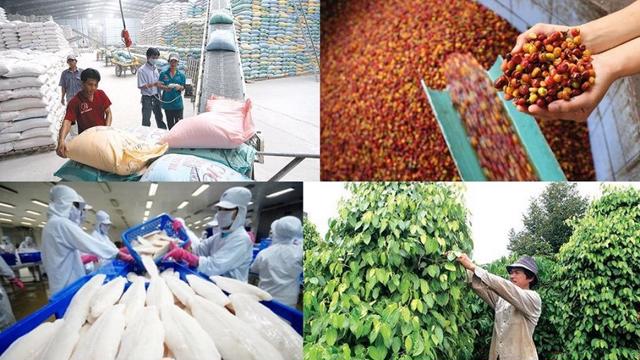[ad_1]
On December 30, 2022, the Ministry of Agriculture and Rural Development held a press conference to announce the results of the agricultural sector in 2022. Accordingly, the value added of the entire industry (GDP) will reach 3.36% in 2022, that is, an increase, the highest in recent years; where agriculture increased by 2.88% (cultivation increased by 1.51%, livestock by 5.93%); Fisheries increased by 4.43%, forestry by 6.13%. Export turnover of agricultural, forest and fishery products reached 53.22 billion US dollars; Trade surplus amounted to USD 8.5 billion.
2023: EXPORT TARGETS OF $54 BILLION
Mr. Nguyen Van Viet, Director of the Planning Department (Ministry of Agriculture and Rural Development), said that the industry’s production structure continues to be appropriately adjusted, more effectively connected to the market, the proportion of products increased, competitive advantage and high-quality.
Grain production in 2022 will reach 47.1 million tons. In particular, rice production reached over 42.7 million tons, which fully met the needs of domestic consumption, processing, animal feed use and export nearly 7.2 million tons.
The production of live meat of all kinds is about 7.05 million tons; in which the production of beef, live pork, poultry, eggs and milk increased from 3.5% to 10.2%. Total seafood production was 9.03 million tons, up 2.7% from 2021.
“The agriculture and rural development sector has set a target of 3% GDP growth in 2023; the total export turnover of agriculture, forestry and fisheries is USD 54 billion; the rate of communities meeting new rural standards is 78%; At least 270 units at the district level have met the standards/completed the task of building new landscapes…”
Mr. Nguyen Van Viet, Director of the Planning Department of the Ministry of Agriculture and Rural Development.
At the same time, the product consumption market continued to expand both in categories and in products, with a focus on the domestic market. Many trade barriers were removed immediately, and exports of agricultural, forestry and fisheries products reached a new record. As a result, the industry has 7 products/product groups with sales in excess of USD 3 billion: wood and wood products; Shrimp; the coffee; Rice; Rubber; Vegetables; cashew.
Forms of production organization were renewed and further developed both quantitatively and qualitatively, and operational efficiency was gradually improved. In 2022, 980 new agricultural cooperatives will be established, bringing the total number of agricultural cooperatives to almost 21,000; of which 65% are classified as good and good, and there are 1,980 cooperatives for high-tech applications, 4,180 cooperatives associated with enterprises in the production, processing and consumption of agricultural products.
Mr. Nguyen Van Viet assessed that in 2023, the economy is expected to continue to face many difficulties and challenges, such as: inflationary pressures and sharp increases in production costs; climate change is becoming increasingly evident and extreme; changes in demand and new consumption patterns; especially the effects of the Russia-Ukraine conflict…
In order to achieve the goals set for 2023, the Agriculture and Rural Development sector continues to promote restructuring towards ecological, modern circular economy development… The units focus on removing difficulties and obstacles, minimizing the negative impact of the epidemic and market fluctuations to increase exports and take advantage of opportunities from free trade agreements for Vietnamese agricultural products.
At the same time, building a value chain for each agricultural product, coupled with the development of agricultural and rural logistics infrastructure to ensure the supply chain of the domestic market.
PROMOTE AGRICULTURAL EXPORTS TO CHINA
According to Mr. Huynh Tan Dat, deputy director of the crop protection department, China is an important market for Vietnam’s agribusiness and therefore regularly coordinates strategies to promote cooperation. Most notably, we recently signed protocols to encourage the official export of sweet potatoes, durian, passion fruit… to this country.

Mr. Nguyen Van Long, director of the animal health department, said the opening up of the Chinese market is being implemented effectively. In dairy products, there were 9 factories belonging to 7 manufacturing companies that met export standards, with a growth rate of up to 50%.
In addition, with the signing of the bird nest export protocol, the Ministry of Agriculture and Rural Development has also issued a document guiding the implementation, and now has companies send documents asking for guidance. Aiming for the first deliveries to this market by 2023.
For livestock products, Mr Long said the department has been coordinating with relevant authorities to establish a foot-and-mouth disease safe area. The two countries’ ministries and branches will sign the agreement, which will create favorable conditions for the production and export of animal products (pork) to China. At the same time, the ministry is also negotiating the export of chicken meat, processed products…
Deputy Minister of Agriculture and Rural Development Phung Duc Tien said China is a potential market with 1.4 billion people accounting for 19.2% of the export market structure. Therefore, the prime minister was keen and instructed to promote the consumption of goods to China.
“Thus, in 2022, when it is officially exported to this market, the durian fruit has grown by 4,100% in just one month through many efforts. In the coming period, many products will be promoted thanks to the signing of protocols for official export,” said Deputy Minister Phung Duc Tien.
HOT PROBLEM OF IMPORTED BUFFET CONTAINING BANNED SUBSTANCES
Referring to the information that buffalo and cows smuggled into Vietnam from Thailand, Cambodia and Laos used lean substances for fattening, Mr. Nguyen Van Long – director of the Ministry of Animal Health, said that as of May 2022, the Ministry of Animal Husbandry Documents were sent by the veterinary authorities of these countries, requesting information on the epidemic situation and the control of prohibited substances in buffalo and cow breeding.
Most recently, at the end of November 2022, the Department of Animal Health proceeded to set up a delegation to Thailand to assess the real situation of the disease and animal production and find a solution.
“The Ministry of Agriculture and Rural Development is considering sending official documents to Laos, Cambodia and Thailand informing that if the illegal import of buffalo and cows cannot be stopped, the import of buffalo and cows will start in early 2023 countries after Vietnam”.
Mr. Phung Duc Tien, Deputy Minister of Agriculture and Rural Development.
So far, the Department of Animal Health has directed the Sub-Department of Animal Health Region 3 — the quarantine authority at border crossings in the central provinces — not to quarantine buffalo and cows imported from those countries without documents, according to the Department of Animal Health and the Ministry of Agriculture and Rural Development.
In addition, the Department of Animal Health is coordinating an investigative project with the police to deal severely with cases of illegally imported buffalo and cows.
“After receiving information that smuggled buffalo and cows used lean substances in the breeding process, the Department of Animal Health directed the sampling units to suspected smugglers and slaughterhouses in Hanoi to examine them. In addition, the Department of Animal Health has provided 5,000 rapid test kits to sites to closely monitor buffalo and cow slaughter facilities nationwide,” Mr. Long said.
Deputy Minister Phung Duc Tien also reiterated, “The problem of illegal imports of buffalo and cows from Thailand, Laos and Cambodia is being firmly addressed by the Ministry of Agriculture and Rural Development.”
In the country, the Ministry of Agriculture and Rural Development instructs the entire veterinary system, especially the central provinces, to strengthen inspection and strict supervision and coordinate with relevant authorities to prevent smuggling. If we cannot control the illegal import of buffalo and cow, and the surrounding countries still allow cattle and buffalo to use banned substances and then sell them to Vietnam, we will order to stop the import of cattle from neighboring countries. .
[ad_2]
Source link

